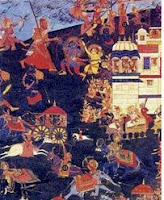The shattered thigh and other plays by Bhasa (translation: A.N.D. Haksar)
Penguin. Pages: xxx+127. Price: Rs. 200/-
Bhasa would have remained an enigma of Sanskrit literature had not Trivandrum’s MTG Sastri discovered some of his works in 1909. Although eulogistically mentioned in the works of Kalidasa, Bana Bhatta, Jayadeva et al, and named in the same breath as Kaviputra, Saumillaka and other great classical Sanskrit litterateurs, only thirteen of his plays survive today. These are based on Harivamsa and the two epics. In this riveting read Haksar has included six of these plays. All are based on the Mahabharata and appear in a sequence beginning with the Pandavas’ exile and ending with Duryodhana’s death wherein Bhasa draws alternate scenarios. For example, in Five Nights (Panchratram) Duryodhana is shown as a man who keeps Abhimanyu with him when Pandavas are exiled, and honours a promise given to Drona and Bhishma by restoring to the Pandavas their kingdom. The Middle One (Madhyama Vyayoga) also creates a situation that is not found in Mahabharata. Here, Bhima fights with Ghatotkacha in order to save a priest family. Both father and son are unaware of each other’s identity – a theme that predates the Rustam-Sohrab saga by several centuries. While reading this fascinating volume one wonders at the sophistication of our ancient literature. Each play is capable of being enacted onstage in its original or adapted version.
Use of metaphors by Jawaharlal Nehru by Rakesh Gupta
Shubhi Publications, Gurgaon. Pages: xvii+229. Price: Rs. 495/-
Scholarly interest in Nehru abides to this day. Gupta’s tome is another evidence of this. Not only has he taken a look at Nehru’s evolution as a politician but also enumerates, albeit briefly, the various events and personalities that helped in shaping his persona. Interestingly, he employs unusual tools to understand India’s first prime minister, viz., interpreting the metaphors Nehru used in his writings, e.g., “the flood of aggression” (the 1962 war), “the thick wall of group hatred” (the situation in Kerala at that time) and many others that were original, evocative and rich in imagery. Gupta has also examined The Glimpses of World History and other writings to unravel the Nehru that was – a visionary, a cosmopolitan, and a nationalist with propensity for didacticism.
Diasporic studies edited by Gurupdesh Singh
GNDU, Amritsar. Pages: x+312. Price: Rs. 225/-.
Although Indians have been migrating – of their own accord or under duress – to various parts of the world for ages it is only now that some interest in them is being evinced. True, quite a lot of literature by Indians living abroad has been written wherein such themes as loss of identity, cultural conflict and assimilation, longing for and romanticizing of the homeland etc have found prominence, but our political as well as intellectual establishments have been indifferent to the Diaspora for long. Lately, however, some amends have been made. This erudite volume is one such step, the scope of which is stated to be limited to Punjabi emigrants but Bengali and other non-Punjabi segments of the Diaspora too come under the scholarly scanner. Along with the works of Naipaul, Rushdie, Rohinton Mistry and Shahid Ali, and the cinematographer Ritwik Ghatak, prominent space has been given to Sadhu Singh Dhami’s novel Maluka and Iqbal Ramoowalia’s The Death of A Passport in the discourse. The attempt in this volume is to focus on the process of the resolution of identity crises in alien climes, and the need for the original racial-cultural-religious identities of immigrants to come to terms with the acquired new national-cultural identity in the host country.
THE TRIBUNE SHORT TAKES






No comments:
Post a Comment